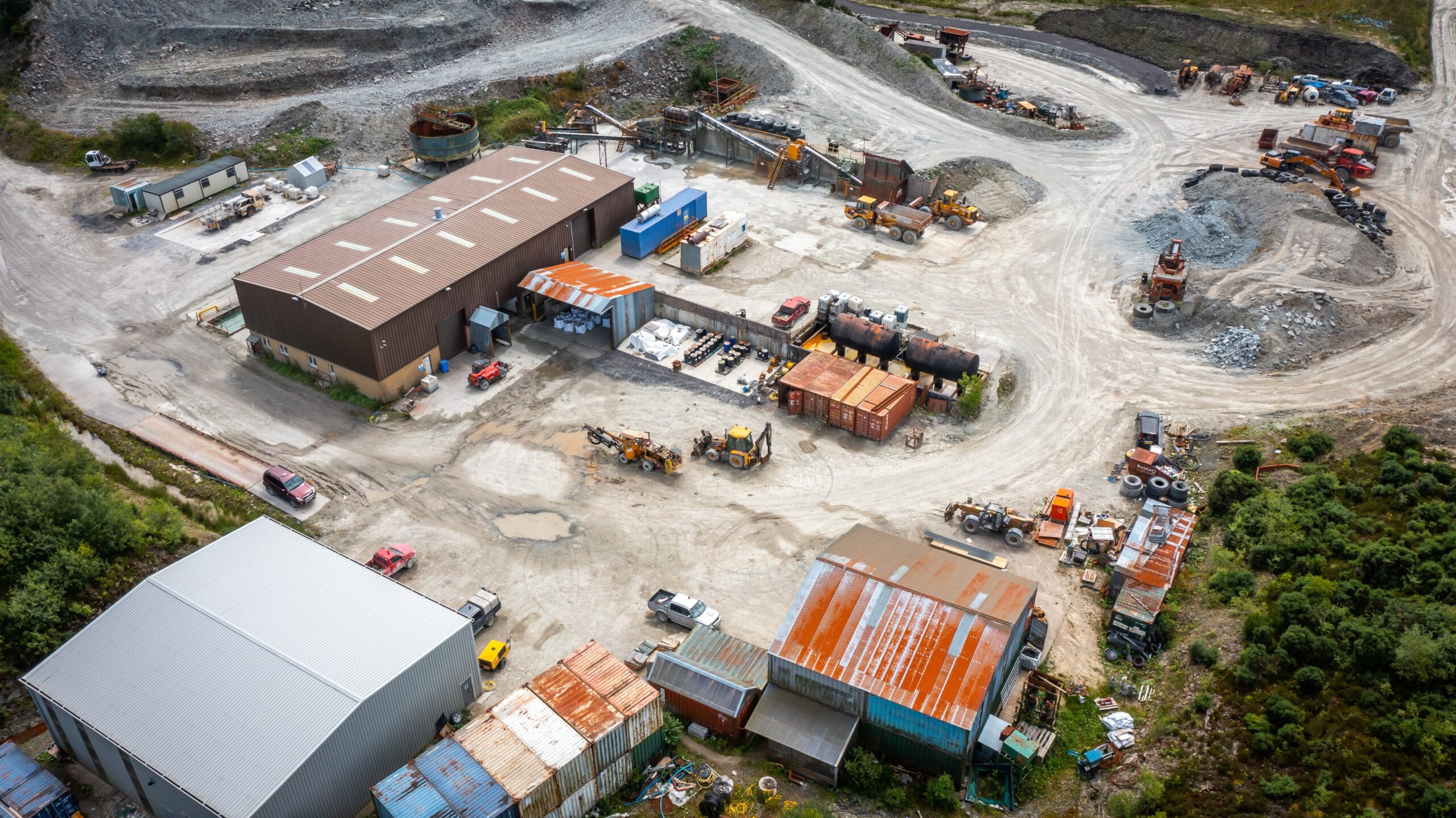Gold: Methods and Approaches in the Region
A061 MAY 2023
Gold mining often invokes immediate associations with cyanide and the negative implications linked to this extraction method. However, it is important to understand the reasons behind its use, as well as explore alternative processes. In the case of Dalradian’s initial planning application for their processing plant in 2017, the mention of utilizing up to 2,100 kilograms of cyanide per day raised concerns within the community.
The local communities expressed significant concerns about the use of cyanide in a local gold mine due to several reasons. Cyanide is commonly used in the extraction process of gold from ore, particularly in large-scale mining operations. However, its use poses several risks to both human health and the environment.
One of the main concerns raised by the local communities is the potential for accidental spills or leaks of cyanide solution. If mishandled or improperly stored, cyanide can contaminate water sources, soil, and ecosystems, leading to severe ecological damage. This contamination can have long-lasting effects on aquatic life, plants, and animals, including the potential for mass fish kills and the disruption of entire ecosystems.
Moreover, cyanide is highly toxic to humans. Exposure to cyanide can have serious health consequences, ranging from respiratory problems and skin irritation to more severe effects on the central nervous system. Accidental exposure to cyanide can occur through inhalation, ingestion, or contact with contaminated water or soil.
Recent cyanide-related disasters in gold mining have further highlighted the associated risks. One notable example is the 2015 Gold King Mine spill in Colorado, United States. In this incident, millions of gallons of cyanide-contaminated wastewater, along with heavy metals, were released into the Animas River, resulting in a major environmental disaster. The spill had severe impacts on the river’s ecosystem, including fish deaths and contamination of water supplies for downstream communities.
Another incident occurred in 2019 in the Ahafo mine in Ghana, operated by Newmont Goldcorp. A storage tank at the mine leaked cyanide solution, contaminating nearby water sources and leading to the deaths of fish and other aquatic organisms. Local communities relying on these water sources for drinking, fishing, and agricultural activities were affected, causing social and economic disruption.
In light of these concerns and incidents, Galantas Gold, the other local gold producer, adopted a different approach. They opted for a less controversial route by producing a concentrated ore and exporting it to a smelter overseas for further processing. This method eliminates the need for on-site cyanide processing and significantly reduces the associated risks of cyanide usage and potential accidents.
Dalradian, after considering the concerns raised by the local communities, made a similar decision. They dropped the cyanide processing element from their planning application, recognizing the potential environmental and health risks involved. Instead, they have chosen a model similar to Galantas’ concentrate route, which mitigates the concerns associated with cyanide use in gold mining.
How are concentrates used as an alternative to the cyanidation process?
Using Concentration Methods
Concentration means increasing the amount of gold in ore or sediment, by selectively removing lighter particles. If employed effectively, concentration methods can eliminate or greatly reduce the need for mercury.
Before concentration can begin, ore must be crushed or milled to liberate gold particles from rock and to decrease grain size. Concentration works best when grain size of the milled material or sediment is relatively consistent, so that most particles are of similar size. An appropriate grain size can be achieved using screens or sieves. Once the gold-containing material has the appropriate grain size, one (or several) of the methods described below can be employed to concentrate gold bearing material.
Most concentration methods rely on the high density of gold relative to other minerals in ore or alluvium mixture. These are referred to as gravity methods. Magnetic or chemical properties can also be exploited to enhance concentration.
Each mining operation is unique. Concentration methods must be selected after considering factors such as the type of ore or sediment, other minerals present, gold particle size, and the availability of water and electricity.
By-products from the concentration process
The waste generated from the concentration process in gold mining can be managed in a couple of ways. One approach is to return the waste to the source opencast pits, while another option is to utilize it as paste backfill for underground operations. However, it’s important to consider the associated risks and challenges involved in these practices.
Due to compaction limitations, only around 50% of the waste can typically be returned to the original excavation site. As a result, additional waste stockpiles are required to accommodate the excess waste. These stockpiles can be quite large and pose potential environmental risks, particularly in terms of water pollution and dust emissions.
The stockpiles can contribute to water pollution through leaching. Naturally occurring harmful materials, including heavy metals, uranium, radon gas, and other substances present in the country rock, can be released into the surrounding environment. This leaching process can contaminate nearby water sources, potentially impacting aquatic ecosystems and posing risks to human health.
In addition to water pollution, dust generation is another concern associated with these waste stockpiles. Wind can carry dust particles containing various minerals and harmful substances, which can have negative effects on air quality and potentially pose respiratory health risks to nearby communities.
Managing and mitigating these environmental risks associated with waste stockpiles requires adherence to strict regulatory guidelines and best practices. Measures such as proper containment structures, runoff management systems, and dust suppression techniques can help minimize the potential negative impacts on the environment and human health. Regular monitoring, maintenance, and remediation efforts may also be necessary to ensure effective waste management and minimize any potential risks posed by these large stockpiles.
Flotation
Flotation is usually used by large scale miners but can also be applied in small scale operations. It is a process that works best for processing complex ore types, especially ores that are difficult to process using gravity methods. In flotation, a mixture of slurry (crushed ore and water) and frothing agents are added into a flotation machine. A tube releases air into the tank of the machine and an agitator creates air bubbles at the bottom of the tank.
Minerals that are hydrophilic, such as gold, attach to the bubbles’ surface and are brought up to the top of the tank. Other minerals fall to the bottom of the tank and are discarded as tailings. Bubbles containing gold and other hydrophilic minerals accumulate at the top of the water level as froth. This froth is then scraped off to create a concentrate of gold and other hydrophilic minerals. Flotation creates high quality concentrates and is good at capturing fine gold. Flotation usually requires a substantial amount of capital investment.
There are a variety of possible frothing agents. Depending on the chemical, specific precautions must be taken when employing the method to protect human health, and waste materials must be disposed of appropriately.
Methyl Isobutyle Carbinoll (MIBC), Potassium Amyle Xanthate (PAX) are used locally at Cavanacaw.
Gold Recovery
At Galantas, the gold ore concentrate is transported to a Canadian smelter in 1 to 1.3-tonne bags. Each bag contains approximately 100 grams per tonne (g/t) of gold, 250 g/t of silver, 10% lead, and varying amounts of arsenic, ranging from 1% to 6%. These bags are stored at the mill on the Cavanacaw site and typically dispatched on a monthly basis.
The concentrate is shipped from Belfast to the smelter using 20-foot containers, with an average shipment weight of 24 tonnes.
Galantas has an off-take agreement with the smelter, whereby they sell their metal to the smelter. The prices received for gold, silver, and lead are 95% of the average price of the previous month. Additionally, there are refining charges and penalties for the presence of arsenic in the concentrate.
Historically, the freight and refining charges have averaged around 15% of the gold price. This means that these charges, including transportation and processing costs, typically amount to approximately 15% of the value of the gold contained in the concentrate.
After the refining process at the smelter, it is important to note that the refiner becomes the owner of the gold. The refined gold is then sold on the open gold market or to other buyers. Galantas, as the original producer, no longer retains ownership of the gold once it has been refined.
Regarding waste disposal, the slag and other waste generated during the refining process are typically disposed of locally at the smelter’s location. It is important to mention that this waste is not returned to Ireland but rather managed and disposed of according to local regulations and best practices at the smelter facility. Proper waste management procedures are in place to minimize any potential environmental impacts associated with the disposal of such waste materials.
The smelter in this case uses the ‘direct smelting’ process
This process was also used to smelt the gold recovered in Dalaradian’s 2014 bulk sample from the Curraghinalt adit.
Direct Smelting
Separation methods, like the ones described above, if employed properly, should yield a high-grade concentrate with a large proportion of gold relative to other materials. However, this gold still needs to be separated from the other remaining minerals before it can be sold. At this point in the process, direct smelting can often be employed as the final stage of gold recovery.
In direct smelting high-grade concentrate is heated until the gold melts. The liquid is then cooled to form a solid mass of gold dore, a semi pure gold alloy, that can reach upwards of 95% purity.
To perform direct smelting, a processing shop employs a crucible, a high temperature bowl designed for smelting. Gold concentrate is combined with a flux, such as borax or other materials of mixtures, in the crucible. The flux acts to decrease the melting temperature and viscosity of non-gold minerals in the concentrate so they are more easily separated from the gold during the cooling process. Concentrate and flux are heated in the crucible to the temperature at which gold melts, 1065 degrees Celsius. After this temperature is maintained for some time the material in the crucible will melt and can then be poured out of the crucible to cool and harden into gold dore..
Chemical Leaching
Chemical leaching makes use of the chemical properties of gold to leach it from ore, concentrate, or tailings. This process is mostly used in large scale mining operations but has been increasingly adopted in small scale mining because of its high gold recovery rate and low cost. The best practices for chemical leaching are a combination of pre-concentration and mill leaching, as they lead to the least amount of waste, a short processing time for miners, and high gold recoveries. First, concentration is done through gravity techniques. Then the concentrate is simultaneously milled and leached. When chemical leaching is employed, it is important for miners to handle the chemicals properly and ensure that they are properly used and stored to avoid health and environmental concerns.
Cyanide is often the preferred chemical used in leaching. Cyanide is highly toxic and great care must be taken when using it. However, in contrast to mercury, cyanide is does not persist in the environment. Cyanide leaching must not be used on tailings where mercury is present, as soluble mercury-cyanide complexes will form, mobilizing mercury to great distances.







